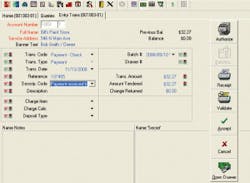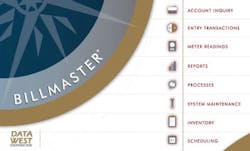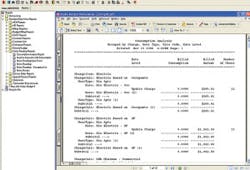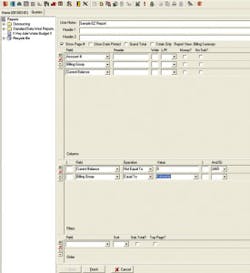Candy Cooper, a utility analyst for the city of Fountain, CO, doesn’t hesitate when running down a list of the benefits her city’s water utility receives from using automated billing software. The software helps the utility find potential leaks in its system, provide customers with far more detailed billing statements, and conserve water. Water conservation isn’t exactly a benefit that most people associate with automatic billing software. But in Fountain, that’s exactly what the city’s billing software lets it do. This is a significant benefit, Cooper says. After all, water is a precious resource. Helping to conserve it should be an important goal of any municipality.
With the automated billing system, the city of Fountain’s utilities department can bill customers on a tiered system. Under this system, the more water that customers use, the more they pay each month for their water. In all, the city’s automated billing system allows Fountain to charge six different rates to customers, all tied into how much water they use on a regular basis. The goal is a simple one: convince customers to be more judicial in how they use water.
“We hope that this helps inspire customers to conserve,” says Cooper. “We find, actually, that in many cases it does. There are always some people who are determined to have that bright green lawn, no matter the costs. But with a certain number of people, the tiered billing system does make a difference. They know they will pay a lower rate for their water if they use less, so they try to conserve their water.”
Cooper and the city of Fountain are far from unusual when it comes to discovering a host of benefits from using water billing software. A growing number of utilities have signed on to the latest automated billing programs, some choosing to automate their billing functions for the first time, others upgrading from harder-to-use legacy systems.
These utilities have one goal when they make the move to a new billing system: They want to operate more efficiently. This leads to cost savings in the long-term. And in today’s challenging national economy, any way that utilities can find to save dollars is much appreciated.
By employing water billing software, utilities can reduce the size of their labor force, providing immediate savings. They won’t need as many utility employees to tackle billing issues if software is doing this job for them. And reducing the number of employees in the billing department doesn’t necessarily mean laying off talented workers. Utilities can train billing department staffers to take on other jobs, whether with the municipal utility or elsewhere in the utility.
Water billing software also allows utility employees to focus their efforts on other tasks. They can spend more time in the utility’s customer service department answering resident questions. They can analyze the reports created by billing software to hunt for potentially costly leaks. And they can study these same reports to determine new ways to conserve water use and reduce the water utility’s overall costs of providing this water to its customers.
Today’s water billing programs provide a host of reports and functions that stretch far beyond simply sending payment notices to consumers. Savvy water utility officials recognize this and use these reports to operate their utilities in a more efficient and cost-effective manner.
“People are always surprised at what they can do with our software,” says Julie Patterson, director of sales and marketing with Durango, CO-based Data West, the publisher of BillMaster utility billing software. “Our customers use our reports to do everything from running their own water use studies, without having to hire someone to do it for them, to researching trends in their water usage. Our software does more than just automate the billing process.”
Making the Move to Automation
Tri C Systems in Carterville, IL, has been providing water and utility billing software to small- to medium-sized utility districts since 1985. Jeff Cross, the company’s vice president, says that utilities today have few reasons not to purchase water billing software. The software and startup costs that utilities must pay to switch from manual or older legacy billing systems to today’s newer products simply is no longer that exorbitant.
To prove this, Cross points to the typical customer of Tri C. The company mainly serves smaller utilities dotting the Midwest. Most of the company’s utility customers bill about 5,000 accounts each month. Many of these companies have never used water billing software before purchasing it from Tri C. These aren’t gigantic utilities, yet they can afford to purchase water billing software. If these smaller utilities can find room in their undoubtedly tight budgets for water billing software, then so can the medium- to large-sized ones across the country.
“For most of these utilities, buying water billing software is a matter of survival,” says Cross. “Doing billing by hand is a tedious time. It’s not easy to do the monthly cyclical billing. It’s hard to get all those bills calculated and printed in some fashion. Then you have to mail them all out. It’s all time-consuming and tedious. Many of our customers had been doing it that way forever. But that’s simply not practical anymore, especially not when you have this technology available to make billing so much easier.”
Water billing software has evolved significantly since Tri C first entered the business. It’s now a far more powerful tool, one that utilities can use not only for automating their billing processes, but for planning system upgrades and identifying customers who may have large leaks.
And while billing software has grown more powerful, it’s actually become less costly for utilities to convert from manual to software-based automated billing systems, Cross says. When Tri C first began selling water billing software way back in 1985, utilities generally had to purchase new printers, forms, and computer technology to go to automated billing systems, he says. At minimum, utilities were looking at an investment of $10,000.
Today, that price has dropped. Utilities already have most of the technology they need to run billing software.
“The investment cost for these programs has certainly plummeted,” say Cross. “There really is no good reason today not to be automated.”
This doesn’t mean, though, that every municipality or utility will jump to add water billing software. Some may simply have a handful of customers who demand unique billing methods, methods that can’t be covered by automated billing software.
Cross points to a hypothetical example of a utility that has 2,000 accounts. Maybe 1,900 of these accounts are straight-forward ones, ones that the utility can easily service with water billing software. The remaining 100, though, might be more complicated. They might be operating under special fee structures that billing systems simply can’t account for.
Even these challenges are easing, though, Cross says. The technology offered by water billing software has improved enough where utilities can service all but the most complex of billing arrangements with it. Even more importantly, utility officials are far more aware of the benefits of using water billing software. This inspires them to request changes from these more complex customers so that they can serve them with water billing software.
“There’s been a change in attitude,” says Cross. “Those 100 accounts that we’ve been bending over backwards for–let’s not do that anymore. Let’s bring them into the fold and modernize our policy at the same time we are modernizing our equipment. Sometimes it’s easier to change policy than it is to change code. Instead of changing a program, you change your policy.”
Even the smallest of utilities are willing to make the leap to automated billing technology today, Cross says. That’s because they recognize that the benefits of this technology are well worth the hassles of switching from older legacy systems–which usually don’t offer the flexibility and features of new programs–or, even worse, paper-and-pen billing methods.
Water conservation isn’t a benefit most people associate with automatic billing software.
“I remember when people tried to do their billing with spreadsheets. It just doesn’t work. It takes too much time and work,” says Cross. “Today, though, utilities are willing to make the changes necessary to go with the newer billing software programs. That’s important. We always say to people that if they buy our program, they need to be flexible enough to realize that they may need to make a whole review of their existing policies. They may need to make sure that their billing policies work well with the billing software that they are purchasing.”
Saving Time and Money
Raetta Leiker, billing administrator for the Parker Water and Sanitation District in Parker, CO, is thrilled that the utility signed up for the BillMaster utility billing software distributed by Data West in 2002. It has since made life far easier for the employees in the utility’s billing department, she says.
Thanks to BillMaster, about 20% of the utility’s customers pay their bills through electronic payments or credits. Another 20% make payments online through their bank. Overall, Leiker says, only about 50% of the district’s customers send their monthly checks directly to the utility’s billing department.
At the same time, the utility’s billing software automatically sends statements, either through e-mail or regular mail, to its customers. This combination saves an incredible amount of time and labor for the utility, Leiker says. It also provides better service to the utility’s paying customers.
“Before going with the billing software, we’d print our statements here, use our fold-and-stuffing machine, and get them in the mail. It was a 12-hour job minimum for us,” says
Leiker. “Then we had a small window of time to get the statements to the post office. We never could make it in that window, so we always had to hold the mailings off for the next day. For the same cost, or lower, actually, we are now automated. It’s made everything so much easier.”
The utility has more than 13,000 customers. By making sure that nearly 50% of these customers don’t mail bills directly to the utility, the billing software has freed up time for the utility’s three billing department staffers. Before signing up for the current system, the utility had one other part-time staffer to help with processing the incoming customer payments.
Doing this work also took employees away from their other billing jobs, says Leiker.
The utility’s billing software also helps with those customers who do send in their checks through the mail. The BillMaster software allows Parker Water and Sanitation employees to scan the payment stubs and checks electronically into the utility’s system, taking, in essence, a photo of these checks. Parker employees then send a file full of these check photos to the bank. This means that billing department employees don’t have to waste time driving customer checks to
the bank.
Leiker estimates that thanks to the billing software, Parker employees have hand-carry less than 1% of their customer checks to the bank.
Parker Water and Sanitation keeps the actual checks from customers in a fireproof safe for two weeks. The district’s employees destroy the checks every two weeks. “The software has changed the way we do business, absolutely,” says Leiker. “We still have to pull all those payments from the envelopes and run them through the remit system, but that’s where the work ends. It images it for us, and we can then send the file to the bank through the software itself. The entire process is streamlined now. It has definitely freed up our time to concentrate more on our other duties.”
Variety Is Out There
The best news for water utilities is that the billing software industry continues to grow. Utilities today can choose from a wide range of billing programs offered by several companies.
Some programs come loaded with special features from which the largest utilities can benefit. Others are more basic and are specifically designed for smaller utilities and municipalities.
InteData Systems, for instance, sells the SOFTWater billing system, which allows customers to automate the bill-paying functions of their water, sewer, sanitation, gas and electric utilities. The program also automatically alerts users when customers with outstanding debt return to the system.
RVS Software’s utility billing software allows municipalities to automatically post their billing information in QuickBooks, a program that many utilities still use to chart their
payments and outstanding bills. Like other programs, RVS’ also allows utility workers to automatically draft customers’ bank accounts for their utility payments. This way, they don’t have to mail checks, freeing utility employees from having to tackle all the work involved with mailing out statements and processing the checks of these customers.
Patterson, with Data West, though, says that these benefits are just the beginning of the positives that bill-paying software brings to utilities. The real power of billing software lies in the reports that it allows users to generate, Patterson says.
“A lot of municipalities use billing software that they can’t get their data out of,” she says. “That’s not efficient. A billing system is only as good as the data that users can get out of it. If you can’t get workable data out of it, what good is there in putting all that data in there?”
Users can study the data from their billing software to determine the times of day in which consumers are using the most and least water, Patterson says. They can also instantly see when rates spike dramatically for particular customers. This can be the sign of a leak in the system. But identifying it early, utility officials can react quickly to solve the problem, Patterson says.
Other customers use billing software to conduct their own in-depth water-usage studies, Patterson says. By doing this, they don’t have to hire pricey outside consultants to do the same work. This is important today; all municipalities, it seems, are struggling with their budgets, trying to make every dollar stretch as far as possible.
“We encourage people to automate,” says Patterson. “It’s the word of the year.”
With automated billing software, utilities can instantly see if consumers have complained about their water bills several times in the past. The utility can then take a closer look at that customer’s past billing to see if there might be a slow leak or some other factor that is causing the customer’s bill to continually rise.
Bill paying software also automatically saves any correspondence that utilities send to customers. Utility employees, then, can instantly access this possibly important information when they are in discussions with these customers.
It’s not surprising, with the benefits of water billing software, that Patterson has seen a greater demand for her company’s products.
“A lot of utilities are ready to leave their old legacy systems,” says Patterson. “They are trying to get the most services for their money. All the utilities are facing budget problems. Everyone is doing the job of more than one person. By having a good solid billing system, utilities can increase their productivity by not having so much work that takes so long.”
Automated in Fountain
Cooper, from the city of Fountain’s utility department, says that her utility’s water billing software has been a major benefit to her department. The utility has been using the software since 1997. Today, Fountain combines it with automated meter reading, or AMR, technology.
Utility officials who need to read meters download the routes they want to read for that particular day into their AMR handheld devices, pulling the information right from the utility’s billing software. The employees then drive these routes, accessing the meter readings with their handheld devices without having to leave their vehicles. They conclude the process by importing that data directly into the customer accounts stored in the utility’s billing software.
“It’s a long way from putting reads in by hand,” says Cooper. “That’s something that we used to do.”
This system saves employees a significant amount of time. It also avoids the possibility of human error. Humans can transpose numbers or enter incorrect digits. The AMR/billing software combination avoids this possibility.
Cooper said that her utility’s billing software allows Fountain to run several in-depth reports for customers. For instance, the utility relies on its billing software to provide the information that makes up a meter reading exception list. The utility studies the water usage of customers over a three-month period. If the billing software shows that water consumption was extremely high during the period, higher than it usually is for that particular customer, the utility can contact the customer. That customer might have a leak.
Then, of course, there’s Fountain’s tiered billing structure, where the more water consumers use the higher rate they pay for that water. This system would never have been possible, Cooper says, without the utility’s billing software.
Billing software also helps the city of Fountain provide more information to customers on their own water usage, says Cooper.
“We get so much feedback on the history of each customer’s account, thanks to the billing software,” she says. “We can tell right away if a customer is using more water than normal. We can do a bar graph to show customers just how much water they are using, say, over the last 12 months. They can then compare to see how their usage compares now to what they had been using 10 months ago. They can then make changes if they need to that will help them reduce their consumption.”
Fountain officials, though, aren’t satisfied. The utility is in the process of moving to an Advanced Metering Infrastructure (AMI) system. With AMI and its billing software, the utility can read and input water usage numbers into their system without its employees even having to leave the office.
Cooper says that customers may not be fully aware of the efficiencies that billing software has brought the utility. But these efficiencies have allowed the utility to better serve its customers, she says.
“Before, when we inputted everything by hand, there was a larger margin of error,” says Cooper. “We were depending on people to input the numbers accurately. Now we have no meter reader writing the numbers down. No one in the office is inputting the numbers by hand. I think customers see fewer errors. Their bill is more accurate than in the past.”




